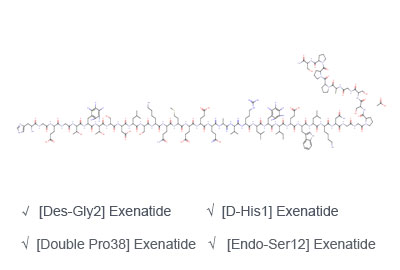Exenatide and diabetes II
Diabetes is a metabolic disease characterized by hyperglycemia, which is one of the most common clinical diseases. For type 2 diabetes, metformin or sulfonylurea drugs are mainly used for blood glucose control in clinical practice, but studies have found that it is very difficult to maintain good control of glycosylated hemoglobin (HbA) after long-term use of these two drugs. Exenatide is a glucagon-like peptide-1 (GLP-1) receptor agonist, an artificial synthesis of insulin secreting peptide (Exendin-4), and a new type of hypoglycemic drug. Exenatide not only has obvious hypoglycemic effect, but also can reduce the weight of patients without causing weight gain, and may also have a variety of cardiovascular benefits, so Exenatide is bound to play an important role in the treatment of diabetes in the future
Diabetes is a hereditary disease characterized by chronic hyperglycemia caused by a variety of causes. it is a metabolic disorder of sugar, fat and protein caused by insulin secretion and (or) function defects. The incidence rate of type 2 diabetes is growing rapidly in many regions of the world. At present, there are about 34 million patients in China, and less than 30% of them reach the standard of blood glucose control. How to adopt a reasonable combined treatment plan and an optimized blood glucose management mode has become an increasingly serious issue.
Good blood glucose control can prevent and delay the occurrence and development of chronic complications of diabetes. Comprehensive evaluation of blood glucose level is the key to good blood glucose control. At present, the clinical indicators reflecting blood glucose control include FBG, PBG and HbA, among which HbA can reflect the average blood glucose level of patients for 8 to 12 weeks, its detection is not affected by the temporary blood glucose concentration, and its blood concentration is stable, and HbA is internationally recognized as the best standard for evaluating long-term blood glucose control

Foreign studies have shown that it is very difficult to maintain good control of HbA for a long time using metformin or sulfonylurea drugs. When oral hypoglycemic drugs cannot effectively control blood sugar, insulin should be added, but long-term use of insulin will increase the risk of cancer in patients. At present, about 10% of diabetes patients in the world get worse every year due to treatment failure.
Pioglitazone is a thiazolidinedione insulin sensitizer, which increases the effect of insulin in circulation by reducing insulin resistance. Animal experiments showed that pioglitazone could increase the utilization of glucose in fat, muscle and liver tissue, inhibit the output of glucose in liver, and significantly reduce the hyperglycemia, hyperinsulinemia and hypertriglyceride status of diabetes animal models. Clinical trials showed that pioglitazone alone or in combination with sulfonylurea and biguanide anti diabetes drugs could significantly reduce blood glucose and HbA.
Exenatide injection is the first approved GLP-1 analog drug, which has many physiological activities, such as stimulating the proliferation and differentiation of pancreatic islet p cells, reducing the gastric emptying rate, and promoting satiety. In addition, animal experiments and small clinical studies suggest that it also has the role of promoting essential B cell proliferation and inhibiting p cell apoptosis. Therefore, many scholars believe that this drug is an ideal drug for the treatment of type 2 diabetes.
Because exenatide impurities is a GLP-1 receptor agonist, it is not easy to be rapidly degraded by dipeptidyl peptidase-IV (DPP-IV) after entering the circulation in the body. It plays a role by specifically activating the GLP-1 receptor and inhibits the rise of postprandial blood glucose; However, metformin hypoglycemic drugs (such as metformin) play a role mainly by reducing the production of liver sugar, reducing the absorption of sugar in the intestine, and increasing the intake and utilization of peripheral sugar. Thus, the mechanism of exenatide
It is very different from traditional biguanide hypoglycemic drugs. Because of the different mechanisms of action of the two drugs, this may be the reason why exenatide has better efficacy in patients with poor blood glucose control of metformin. However, exenatide is mainly excreted by the kidney, so it is not suitable for patients with moderate to severe renal damage or end-stage renal disease.
From www.omizzur.com
Read Related Articles:
Copyright © 2020 Omizzur Inc | Terms & Conditions | Privacy Notice | Sitemap